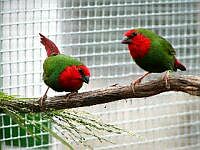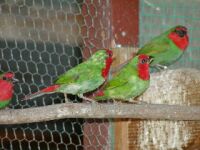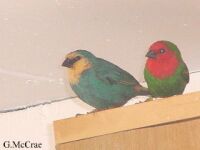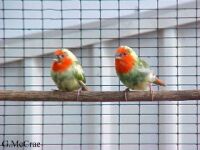|
If you have ever 'done the rounds' on an aviary visit you have
probably peered into many a finch aviary for a glimpse of its
inhabitants. While recently in the Barossa Valley, South Australia, I
was doing just this in company with a number of 'parrot people' many of
who were rapidly becoming bored with straining their eyes trying to pick
out finches in planted aviaries! I was receiving a 'gentle ribbing' and
being told to "get some real birds" when a finch shot out into the
sunlight and proceeded to trill to all the onlookers. "Gotta get me some
of them", one parrot man remarked. Another suggested it was the most
beautiful bird he'd seen.
'It' was a male Red-faced Parrotfinch, Erythura psittacea.
If you can imagine a bird about 11-12cms long that has a stunning green
body, a vivid red head and tail then you have a fair idea of the beauty
that graced us with its presence. Enough of my feeble attempts to
describe them - check out the photos!
The Red-faced Parrotfinch is now firmly entrenched in
Australian aviculture and is freely available for a modest sum these
days. However, it was a different story around 20 years ago. I still
remember the first attempts to keep and breed them in Tasmania when they
were way above my humble price range! Despite originating from the far
warmer climes of New Caledonia they are now at home even in our
err
.'moderate' climate! In fact they are bred in a number of aviary
designs - from 'lawn-locker' types to large, fully roofed, planted
flights. The one compromise we must make is to separate the pairs to
discourage winter breeding and egg bound hens - or worse! In their
native habitat they are, apparently, quite common and one member of a
club I belonged to asked about them while there on holiday a while back
and a villager offered to get the children in the village to get him a
sugar bag full for $5!!
| |
 |
|
| |
Pair - Hen on right |
|
SEXING:
So you've seen the pictures and have decided to get hold
of a pair of these. How do you sex them then? Well, here I'll have to
consult with others 'far more knowledgeable than I'. They seemed to come
up with these points:
"If you can get youngsters straight out of the nest you should find
that cocks come out with red on the chest and/or head and the hens are
simply green all over". I have had several pairs sexed this way and, so
far, I have had 100% success. The person that showed me this admits
that, of late, this method has not proved infallible!
In a mature 'classical' pair the hen is often smaller; has a less
prominent red head mask which does not usually extend past the eye; the
lores (between the eye and the beak) are often a light brown - as
against the males darker black or red; if 'really mature' the red
colouration of the hen is often more 'washed out' and orange.
Some people sex them by blowing on the vents like canary breeders.
Males tend to have a prominent 'lump' and the vent appears separate from
the rest of the body and points downwards while the hen has no such lump
and the vent points straight out behind. My apologies to 'proper' canary
people - perhaps you should consult one if unsure! Males also tended to
have a few red feathers around the vent. I have seen birds sexed in this
manner and it was during the breeding season but I could denote no such
difference in juvenile birds.
In most birds only the males will trill long enough for it to be
called a 'song'. I have heard cock birds trilling but it was usually
only in the breeding season. I have never heard a hen indulge in an
extended burst of this trilling.
If juvenile buy six and hope you get a few hens!! Maybe you will be
able to discern a subtle difference in the green body colour - males are
often brighter in natural sunlight.
One well-known breeder sexes his young birds by the squeals they emit
when handled. In his experience only the hens will 'squeal' when handled
and he has never heard a male do this!
FEEDING:
Our birds are fed Peppers Superior Finch Mix and Greens n'
Grains mix. They appear to prefer the plain canary and white millet
rather than the smaller pannicum seeds. The great thing about these
birds is that they will eat everything that you put in front of them but
beware they also have the habit of scratching through feeders like
chooks! If you are planning on introducing a new food stuff into your
aviaries make sure that you have Red-face in there and they will show
all your birds how to eat it! Just like a canary!
Green and dried seeding heads are relished as are dandelions,
chickweed and silverbeet (if nothing greener is available!). Plain cake
is fed in small quantities as other aviculturists have stated that these
birds tend to gorge themselves to a degree where they eat little else.
Most softfood, soaked seed and supplements are also sampled.
Livefood in the form of maggots and mealworms are taken -
especially during the breeding season. They will squeeze the contents of
the mealworms out like a tube of toothpaste and discard the skins. I
read 'many moons' ago that our European counterparts used to lightly
cook their mealworms and peel them as the skins were thought to be
hazardous to digestion in these birds - obviously our birds have read
the same article and leave the skins alone!
Basically Red-face will eat anything you present them with
and as long as you maintain a constant supply of 'goodies' they should
present you with a number of youngsters. This bird is also 'addicted' to
Lebanese cucumbers, which it will consume with gusto at every
opportunity - great source of vitamin-C.
|
 |
 |
 |
|
Chicks! |
Light Pieds. |
Seagreen & Normal. |
BREEDING:
Opinion differs as to whether they are best kept as
single pairs or in small colonies of 3-4 pairs. There are several
breeders that favour each method but all quote great success with either
arrangement. With a single pair it gives you far greater knowledge of
parentage - very important when breeding the various mutations. They
will nest in any type of nest box or wicker basket you give them or they
will renovate another birds 'left-over' nest or construct their own
structure. Most feathers, lintus, coconut fibre, green grass and swamp
grass are acceptable for this purpose. They have a real fondness for Emu
feathers in their nest building and these can often prove to be a
stimulus for the onset of nest building activity. The height of the
nesting site varies but Gary McCrae, a noted breeder of these birds,
places a number of his nest boxes ½ metre from the floor with excellent
results. Allan Oliver also related that a number of his birds would
build their own nest in tea-tree at about the same height. My own showed
a preference for wooden nest boxes but were placed near the top of the
aviary because that was where I put them! When placing nest boxes or
wicker baskets it is advised that you have twice as many receptacles as
you have pairs as some pairs will recommence laying whilst still feeding
nestlings. The availability of extra nest sites means that they wont be
forced to use the same nest box and risk the fledging young breaking the
new eggs.
In my experience this bird appears to suffer from heat stress
when temperatures rise in the aviary so this lower nesting may be a
mechanism for avoiding the higher temperatures near the top of the
aviary - I have lost nests of young from these raised positions as has
Allan, but the lower nests were not affected. Topic for further research
maybe?
A number of breeders have stated that the Red Parrotfinch
prefers to nest in darkened secluded corners of the aviary. It would
seem like good sense to prepare just such an area in your aviary where
they can hide if you are thinking of obtaining a pair of these finches.
Young, first season, pairs of these birds are often highly
variable as parents. Some will hatch chicks and neglect them; return to
nest and hatch more then rear them for a week and then abandon them.
This can go on for 3-4 nests so that you are tempted to leave the air
rifle up against their cage as a 'hint' of what might happen if they
don't cease this annoying behaviour! Well, next season these same pair
of birds will probably rear 4-5 nests of perfectly healthy chicks with
no problems. I have had this happen on many occasions and succumbed to
using Blue-faced Parrotfinches, E.trichroa, as fosters out of
sheer desperation. The interesting thing was that the Blue Face would
neglect their own chicks and raise ALL of the Red-face chicks - and we
profess to know all about finches! To illustrate this I found a nest of
3 tiny, cold Red Face that were revived and placed in with 3 Blue-face
chicks that were twice their size. I intended to return and place them
somewhere 'more appropriate' but promptly forgot all about them. You
guessed it, the parents raised 3 healthy Red-face and I could find no
trace of their own progeny in the nest!! Makes you wonder if baby
Red-face have the manners of Velociraptors!
The clutch usually consists of 4-6 eggs and fertility is
generally around 85-90%. During breeding the parents will be even more
active than normal and will 'sweat' on you coming in with more greens
and livefood for their chicks.
Young will sometimes return to the nest once fledged, a trait
we pray for down here, but many will simply roost on the perch. Chicks
often leave the nest before they can fly and will flutter around the
floor of your aviary. One breeder used to find that these birds would
often die on colder nights so he placed a few bushy branches of tea-tree
on the floor for the youngsters to roost on - this dramatically reduced
the number of lost chicks, and not just Red-face.
They should always have access to clean, fresh water, as they
will bathe in zero degree temperatures if you let them! As a word of
warning try not to refresh their water bowl late in the afternoon on
cold days as they will bathe and could suffer pneumonia - "see fresh
water, bathe in it!"
HEALTH:
"If this bird is not going at 100km/hr then start to panic!"
A quote that I well remember as the most accurate way of describing the
health of Red-face. They are one of the most active birds in any finch
collection and if you see them sitting still during the day then chances
are that they are ill.
This 'active lifestyle' and inquisitive nature means that
these birds spend a great deal of their time on the ground and should be
regularly wormed - especially for tapeworm, as should any bird that
consumes a great deal of live food. Our birds are regularly treated for
coccidia and protozoal parasites. If compost heaps or damp floors exist
in the aviary I would imagine that they would be prone to fungal
infection. My own experiences with tapeworm in this species were
devastating. I used a product that claimed to be able to remove tapeworm
but following a number of microscopic analyses, proved to be as useful
as raspberry cordial! Once I 'found' a product that DID remove tapeworm
my breeding went from ordinary to excellent in a few months.
When these birds are moved they will often go into a heavy
moult and care should be taken to ensure that they are given some form
of moulting tonic or, at the very least, a multi-vitamin supplement
during this stressful period.
All things considered they are now a reasonably vigorous bird
and will even bathe in the ice-cold waters of Tasmania in winter - they
will even wait for you to crack the ice on their water bowl so that they
can have a bath!!
A good health program and limiting their nesting to 3-4 nest
every year should see these birds in your collection for a number of
years. But, be warned, miss their worming and you will lose these birds
very rapidly.
MUTATIONS:
These birds now come in a range of colour schemes that
are eagerly sought after by a number of breeders. As "beauty is in the
eye of the beholder" I will limit my comments on making comparisons to
the 'normal' coloured birds!
Sea-Green: in these the green of the body is replaced
by a pale sea-green colour and the chest, tail and head is a pale
orange, or even duller. This is a sex-linked mutation, which means that
it can be carried by a male that is 'split' (heterozygous or has one
dominant gene for normal colour and one recessive gene for sea-green)
but a female is either sea-green or normal. There is also a darker form
of the sea green that some call 'par blue' where the body colour is a
deeper blue.
Pied: There appears to be a number of 'classes' of
these with birds either being a light, medium or heavy pied. There is
some debate as to what constitutes each class but a heavy pied has, I am
led to believe, around 70-75% yellow instead of green. In the pied the
beautiful green of the body is splashed with areas of yellow. The
genetics of this appear to be a 'little muddled' depending upon whom you
read first! Most swear that it is a dominant mutation. Well, it may well
be, but it must also have something to do with a acquired trait as birds
that have a normal mother and a pied father may leave the nest with no
pied in them yet they will show it after 2-3 moults. Other breeders
point to the fact that it must be a random gene where some young in a
nest of pieds will show a marked amount of pied while others only a
feather or two - and some none (that is obvious to our eyes at least!).
An accepted trait is that pieds will have a yellow beak, or at least a
mandible, from when it is in the nest and others state that the colour
of the toes can be an indicator - the lighter the toes the greater
chance of the youngster being a pied. There is a bird that has hardly
any green on it at all and some call it a 'double factor' or others a
'very, heavy pied'! But should it be called a yellow if it doesn't have
enough green left to quantify it as a pied? With pieds there appears to
be an imbalance of males so purchase your pairs from someone you trust
to sex them correctly!
|
Group of Mutations! |
Medium Pieds. |
Par-Blue Seagreen. |
As mentioned, as these birds moult the areas of yellow
increases such that a light pied can become a medium pied, and so on, so
make sure you know the ages of the birds you are getting as you might
find your beautiful heavy pied has a pension card! Thus saying a
'proper' heavy pied should/may leave the nest with the correct
percentage of yellow - although some have issue with that statement too!
All breeders contacted agreed that you can breed heavy pieds
form two light pieds and it did not necessarily follow that two heavy
pieds mated together would give you a nest full of heavy pieds. In other
word put any two pieds together and be prepared for anything, sit back
and hope for the best!
Sea-Green Pied: As the name suggests this is achieved
by crossing a sea-green with a pied. The sea-green part is sex linked
(carried on the sex chromosomes only) but the pied is autosomal (carried
on the 'body' chromosomes - anywhere BUT on the sex chromosomes). Both
male and females will show the pied trait but only males can be 'split'
for sea-green. Females are either sea-green pieds or else they are just
pied.
CONCLUSION:
This species is arguably one of the most beautiful birds
available to us here in Australia and it is a credit to Australian
aviculturists that they are secure in our aviaries. They are generally
free breeders and easy to maintain but they also require a rigorous
health program to keep them in good order. They are not as boisterous as
their cousins the Blue-face and have the potential to produce many
youngsters with the addition of a few extras during the breeding season.
Hens are particularly prone to 'burn out' unless you are fairly ruthless
on stopping their breeding and prevent them from breeding during the
colder months.
Whether you are into unlocking the secrets of the genetics of
the pied bird or simply looking for a bird that will be the envy of all
those hookbill people then you could make no better choice that the
Red-faced Parrotfinch.
My thanks to Gary McCrae for his invaluable input, the use of
his photos and for suffering through my many questions and to Allan
Oliver for his advice in the preparation of this article.
By Marcus Pollard -
Previously Published in Australian Birdkeeper.
Copyright remains with the author.
For more on the Red-face
visit the website below!!

|







